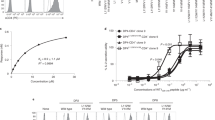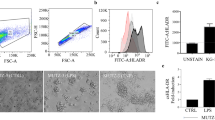Abstract
MAJOR histocompatibility complex (MHC) class II molecules are highly polymorphic cell-surface glycoproteins that present antigenic peptides to CD4+ T lymphocytes. The normal assembly of class II molecules with cognate peptides for antigen presentation requires an accessory function provided by a gene mapping to the class II region of the HLA complex1,2. The isolation of somatic cell mutants of antigen-presenting cells (APC) has shown that at least one gene which maps between HLA-DP and HLA-DQ, provisionally designated c2p-1 (ref. 3), mediates this process1,2,4. Here we describe a unique new mutant 2.2.93, which manifests defective formation of class II/peptide complexes like that described in c2p-1 mutants. We show that (1) mutant 2.2.93 contains a mutation in HLA-DMA5, and a representative c2p-1 mutant, 9.5.3, contains a mutation in HLA-DMB5; and (2) transfection and expression of DMA complementary DNA in 2.2.93, and DMB cDNA in 9.5.3, reverses their mutant phenotypes. These results show that HLA-DMA and -DMB, genes of previously unknown function mapping between HLA-DP and HLA-DQ5, are required for the normal assembly of peptides with MHC class II molecules. They suggest that HLA-DMA and -DMB encode subunits of a functional heterodimer which is critical in the pathway of class II antigen presentation.
This is a preview of subscription content, access via your institution
Access options
Subscribe to this journal
Receive 51 print issues and online access
$199.00 per year
only $3.90 per issue
Buy this article
- Purchase on SpringerLink
- Instant access to full article PDF
Prices may be subject to local taxes which are calculated during checkout
Similar content being viewed by others
References
Mellins, E., Kempin, S., Smith, L., Monji, T. & Pious, D. J. exp. Med. 174, 1607–1615 (1991).
Ceman, S., Rudersdorf, R., Long, E. O. & DeMars, R. J. Immun. 149, 754–761 (1992).
Pious, D., Fling, S. & Monji, T. in Antigen Processing and Presentation (eds Humphries, R. & Pierce, S.) (Academic, New York, in the press).
Riberdy, J. M. & Cresswell, P. J. Immun. 148, 2586–2590 (1992).
Kelly, A. P., Monaco, J. J., Cho, S. & Trowsdale, J. Nature 353, 571–573 (1991).
Mellins, E. et al. Nature 343, 71–74 (1990).
Spies, T. et al. Nature 348, 744–747 (1990).
Levine, F. Proc. natn. Acad. Sci. U.S.A. 82, 3741–3745 (1985).
Pious, D., Soderland, C. & Gladstone, P. Immunogenetics 4, 437–448 (1977).
Pious, D., Dixon, L., Levine, F., Cotner, T. & Johnson, R. J. exp. Med. 162, 1193–1207 (1985).
Germain, R. N. & Hendrix, L. R. Nature 353, 134–139 (1991).
Sadegh-Nasseri, S. & Germain, R. N. Nature 353, 167–170 (1991).
Mellins, E. J. exp. Med. 179, 541–549 (1993).
Sette, A. et al. Science 258, 1801–1804 (1992).
Riberdy, J. M., Newcombe, J. R., Surman, M. J., Barbosa, J. A. & Cresswell, P. Nature 360, 474–477 (1992).
Gladstone, P., Fueresz, L. & Pious, D. Proc. natn. Acad. Sci. U.S.A. 79, 1235–1239 (1982).
Campbell, D. R. & Trowsdale, J. Immun. Today 14, 349–352 (1993).
Koning, F., Schrueder, I., Giphard, M. & Bruning, H. Hum. Immun. 9, 221–230 (1984).
Miller, A. D. & Rosman, G. J. BioTechniques 7, 980–990 (1989).
Lampson, L. A. & Levy, R. J. Immun. 125, 293–299 (1980).
Johnson, J. et al. J. exp. Med. 156, 104–111 (1982).
Bodmer, J. G., Heyes, J. M. & Lindsay, J. in Histocompatibility Testing (eds Albert, E. D., Baur, M. P. & Mayr, W. R.) (Springer, Berlin, 1985).
Clark, E. A. et al. J. Immun. 143, 3873–3880 (1989).
Viken, H. D., Gaudernack, G. & Thorsby, E. Tiss. Antigens 34, 250–259 (1989).
Levine, F., Erlich, H. A., Mach, B. & Pious, D. J. Immun. 134, 637–640 (1985).
Guy, K. et al. Eur. J. Immun. 12, 942–948 (1982).
Clark, E. A. & Yakoshi, T. in Leucocyte Typing (eds Bernard, A., Baunsell, L., Dausset, J. & Schlossman, S.) (Springer, Heidelberg, 1984).
Antonelli, P., Nisperos, B., Braun, M. & Hansen, J. A. Hum. Immun. 11, 11–18 (1984).
Margolskee, R., Kavathas, P. & Berg, P. Molec. cell. Biol. 8, 2837–2842 (1988).
Stockschlaeder, M. A. R., Storb, R., Osborne, W. R. A. & Miller, A. D. Hum. Gene Ther. 2, 33–39 (1991).
Author information
Authors and Affiliations
Rights and permissions
About this article
Cite this article
Fling, S., Arp, B. & Pious, D. HLA-DMA and -DMB genes are both required for MHC class II/peptide complex formation in antigen-presenting cells. Nature 368, 554–558 (1994). https://doi.org/10.1038/368554a0
Received:
Accepted:
Issue date:
DOI: https://doi.org/10.1038/368554a0
This article is cited by
-
Markers of immune dysregulation in response to the ageing gut: insights from aged murine gut microbiota transplants
BMC Gastroenterology (2022)
-
Transcriptome analysis of signaling pathways of human peritoneal mesothelial cells in response to different osmotic agents in a peritoneal dialysis solution
BMC Nephrology (2019)
-
A personal retrospective on the mechanisms of antigen processing
Immunogenetics (2019)
-
HLA-DP84Gly constitutively presents endogenous peptides generated by the class I antigen processing pathway
Nature Communications (2017)
-
The human‐specific invariant chain isoform Iip35 modulates Iip33 trafficking and function
Immunology & Cell Biology (2014)



